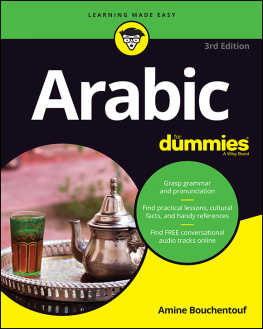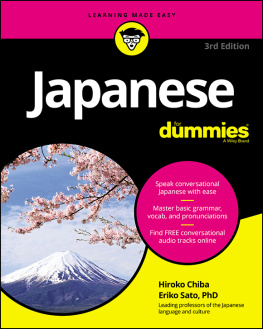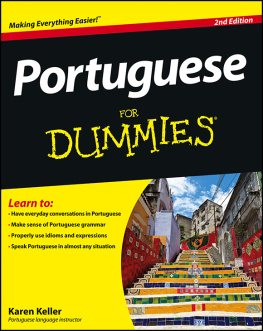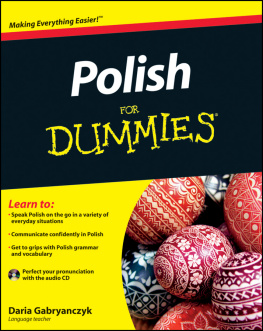

Arabic For Dummies, 3rd Edition
Published by: John Wiley & Sons, Inc., 111 River Street, Hoboken, NJ 07030-5774, www.wiley.com
Copyright 2018 by John Wiley & Sons, Inc., Hoboken, New Jersey
Published simultaneously in Canada
No part of this publication may be reproduced, stored in a retrieval system or transmitted in any form or by any means, electronic, mechanical, photocopying, recording, scanning or otherwise, except as permitted under Sections 107 or 108 of the 1976 United States Copyright Act, without the prior written permission of the Publisher. Requests to the Publisher for permission should be addressed to the Permissions Department, John Wiley & Sons, Inc., 111 River Street, Hoboken, NJ 07030, (201) 748-6011, fax (201) 748-6008, or online at http://www.wiley.com/go/permissions .
Trademarks: Wiley, For Dummies, the Dummies Man logo, Dummies.com, Making Everything Easier, and related trade dress are trademarks or registered trademarks of John Wiley & Sons, Inc., and may not be used without written permission. All other trademarks are the property of their respective owners. John Wiley & Sons, Inc., is not associated with any product or vendor mentioned in this book.
LIMIT OF LIABILITY/DISCLAIMER OF WARRANTY: WHILE THE PUBLISHER AND AUTHOR HAVE USED THEIR BEST EFFORTS IN PREPARING THIS BOOK, THEY MAKE NO REPRESENTATIONS OR WARRANTIES WITH RESPECT TO THE ACCURACY OR COMPLETENESS OF THE CONTENTS OF THIS BOOK AND SPECIFICALLY DISCLAIM ANY IMPLIED WARRANTIES OF MERCHANTABILITY OR FITNESS FOR A PARTICULAR PURPOSE. NO WARRANTY MAY BE CREATED OR EXTENDED BY SALES REPRESENTATIVES OR WRITTEN SALES MATERIALS. THE ADVICE AND STRATEGIES CONTAINED HEREIN MAY NOT BE SUITABLE FOR YOUR SITUATION. YOU SHOULD CONSULT WITH A PROFESSIONAL WHERE APPROPRIATE. NEITHER THE PUBLISHER NOR THE AUTHOR SHALL BE LIABLE FOR DAMAGES ARISING HEREFROM.
For general information on our other products and services, please contact our Customer Care Department within the U.S. at 877-762-2974, outside the U.S. at 317-572-3993, or fax 317-572-4002. For technical support, please visit https://hub.wiley.com/community/support/dummies .
Wiley publishes in a variety of print and electronic formats and by print-on-demand. Some material included with standard print versions of this book may not be included in e-books or in print-on-demand. If this book refers to media such as a CD or DVD that is not included in the version you purchased, you may download this material at http://booksupport.wiley.com . For more information about Wiley products, visit www.wiley.com .
Library of Congress Control Number: 2018949880
ISBN 978-1-119-47539-2 (pbk); ISBN 978-1-119-47556-9 (ebk); ISBN 978-1-119-47548-4 (ebk)
Arabic For Dummies
To view this book's Cheat Sheet, simply go to www.dummies.com and search for Arabic For Dummies Cheat Sheet in the Search box.
Table of Contents
Guide
Pages
Introduction
Arabic, the official language of more than 27 countries, is the mother tongue of more than 420 million people. Its spoken throughout the Middle East, from Morocco to Iraq. Additionally, because Arabic is the language of the Koran and Islam, more than 1.3 billion people across the world understand it.
Due to recent geopolitical events, Arabic has catapulted to the top of the list of important world languages. Even in countries where Arabic isnt the official language, people are scrambling to master this important and vital global language.
For people in North America and Europe, at first glance Arabic seems like a difficult language to master; after all, it isnt a Romance language and doesnt use the Latin alphabet. However, like any other language, Arabic is governed by a set of rules, and when you master these rules, youre able to speak Arabic like a native speaker!
Arabic For Dummies, 3rd Edition, is designed to identify and explain the rules that govern the Arabic language in the easiest and most interactive way possible. I organize each chapter in a straightforward and coherent manner and present the material in an interactive and engaging way.
About This Book
Unlike most books on the Arabic language, I have written Arabic For Dummies, 3rd Edition, in a way that gives you the most accurate and in-depth information available to help you develop and improve your conversational skills. The book is modular in nature, which means every chapter is organized in such a way that you dont have to read the whole book in order to understand the topic thats discussed. Feel free to jump to chapters and sections to suit your specific needs. Also, I explain every grammatical and linguistic point in plain English so that you can incorporate the concept immediately. I take great care to explain every concept clearly and succinctly.
To provide the best foundation and the widest usage for students of Arabic, Arabic For Dummies, 3rd Edition, focuses on Modern Standard Arabic (MSA), which is the most widely used form of Arabic in the world. Arabic basically has three different types:
- Koranic Arabic: This is the Arabic used to write the Koran, the holy book for Muslims. This form of Arabic is very rigid and hasnt changed much since the Koran was written approximately 1,500 years ago. Koranic Arabic is widely used in religious circles for prayer, discussions of Islamic issues, and serious deliberations. Its usage is limited primarily to a strict religious context. Its the equivalent of Biblical English.
The regional dialects: Theyre the most informal type of Arabic. They tend to fall into four geographical categories:
- North African dialect (Morocco, Algeria, Tunisia, and Libya)
- Egyptian dialect (Egypt)
- Gulf Arabic (Saudi Arabia, Kuwait, Iraq, Qatar, and the United Arab Emirates)
- Levantine dialect (parts of Syria, Palestine, and Jordan)
Even though the words are pronounced differently and some of the everyday expressions differ dramatically from region to region, speakers from different regions can understand each other. The common denominator for the regional dialects is that theyre all based on MSA.
- Modern Standard Arabic (MSA): This is the most widely used and understood form of Arabic in the world. MSA is the language that Arabic anchors use to present the news, and professionals use to discuss business and technical issues.
Throughout the book, each new Arabic word appears in Arabic script and boldface, followed by the transliteration system used by the Library of Congress, which is how you properly pronounce it (with the stressed syllables italicized), and its English equivalent in parentheses.
Because this is a language book, I include some sections to help you master the linguistic concepts with greater ease. Heres a description of the specialty sections you find in each chapter:
- Talkin the Talk dialogues: Heres where you get to see Arabic in action. These common Arabic dialogues show you how to use important vocabulary words and terms you should be aware of.
- Words to Know blackboards: An important part of mastering a new language is becoming familiar with important words and phrases. Key terms that I recommend you memorize are included in these sections, which present the transcription of the Arabic word in Arabic script, the transliteration (the pronunciation; stressed syllables are underlined), and the translation.
Next page
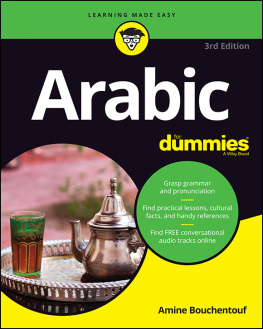

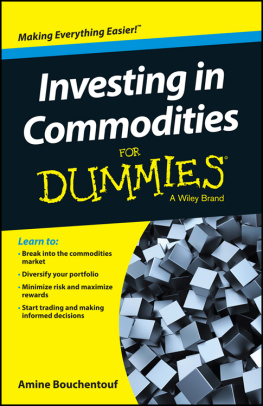
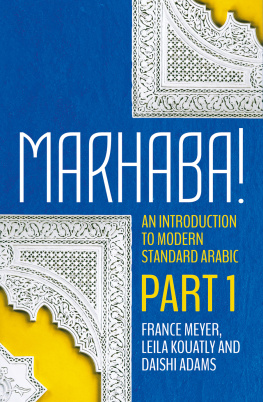
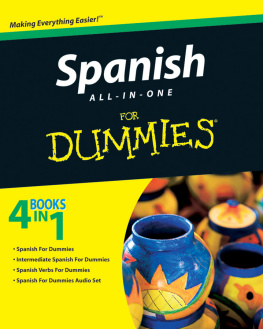
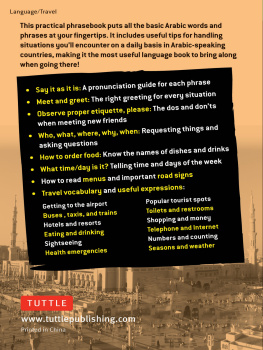
![Kraynak - Spanish All-In-One for Dummies [With CDROM]](/uploads/posts/book/250613/thumbs/kraynak-spanish-all-in-one-for-dummies-with.jpg)


